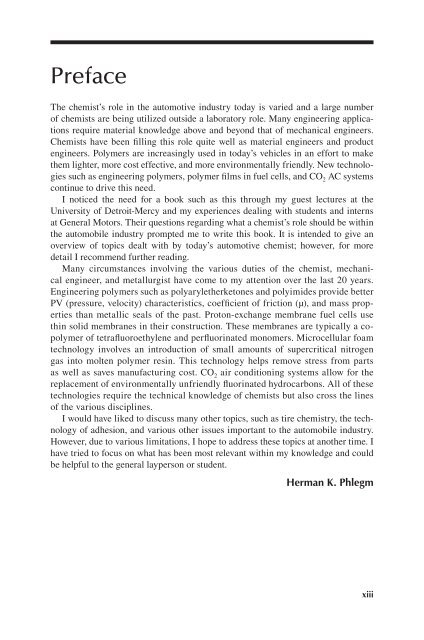THE ROLE OF THE
THE ROLE OF THE
THE ROLE OF THE
You also want an ePaper? Increase the reach of your titles
YUMPU automatically turns print PDFs into web optimized ePapers that Google loves.
Preface<br />
The chemist’s role in the automotive industry today is varied and a large number<br />
of chemists are being utilized outside a laboratory role. Many engineering applications<br />
require material knowledge above and beyond that of mechanical engineers.<br />
Chemists have been filling this role quite well as material engineers and product<br />
engineers. Polymers are increasingly used in today’s vehicles in an effort to make<br />
them lighter, more cost effective, and more environmentally friendly. New technologies<br />
such as engineering polymers, polymer films in fuel cells, and CO 2 AC systems<br />
continue to drive this need.<br />
I noticed the need for a book such as this through my guest lectures at the<br />
University of Detroit-Mercy and my experiences dealing with students and interns<br />
at General Motors. Their questions regarding what a chemist’s role should be within<br />
the automobile industry prompted me to write this book. It is intended to give an<br />
overview of topics dealt with by today’s automotive chemist; however, for more<br />
detail I recommend further reading.<br />
Many circumstances involving the various duties of the chemist, mechanical<br />
engineer, and metallurgist have come to my attention over the last 20 years.<br />
Engineering polymers such as polyaryletherketones and polyimides provide better<br />
PV (pressure, velocity) characteristics, coefficient of friction (µ), and mass properties<br />
than metallic seals of the past. Proton-exchange membrane fuel cells use<br />
thin solid membranes in their construction. These membranes are typically a copolymer<br />
of tetrafluoroethylene and perfluorinated monomers. Microcellular foam<br />
technology involves an introduction of small amounts of supercritical nitrogen<br />
gas into molten polymer resin. This technology helps remove stress from parts<br />
as well as saves manufacturing cost. CO 2 air conditioning systems allow for the<br />
replacement of environmentally unfriendly fluorinated hydrocarbons. All of these<br />
technologies require the technical knowledge of chemists but also cross the lines<br />
of the various disciplines.<br />
I would have liked to discuss many other topics, such as tire chemistry, the technology<br />
of adhesion, and various other issues important to the automobile industry.<br />
However, due to various limitations, I hope to address these topics at another time. I<br />
have tried to focus on what has been most relevant within my knowledge and could<br />
be helpful to the general layperson or student.<br />
Herman K. Phlegm<br />
xiii







